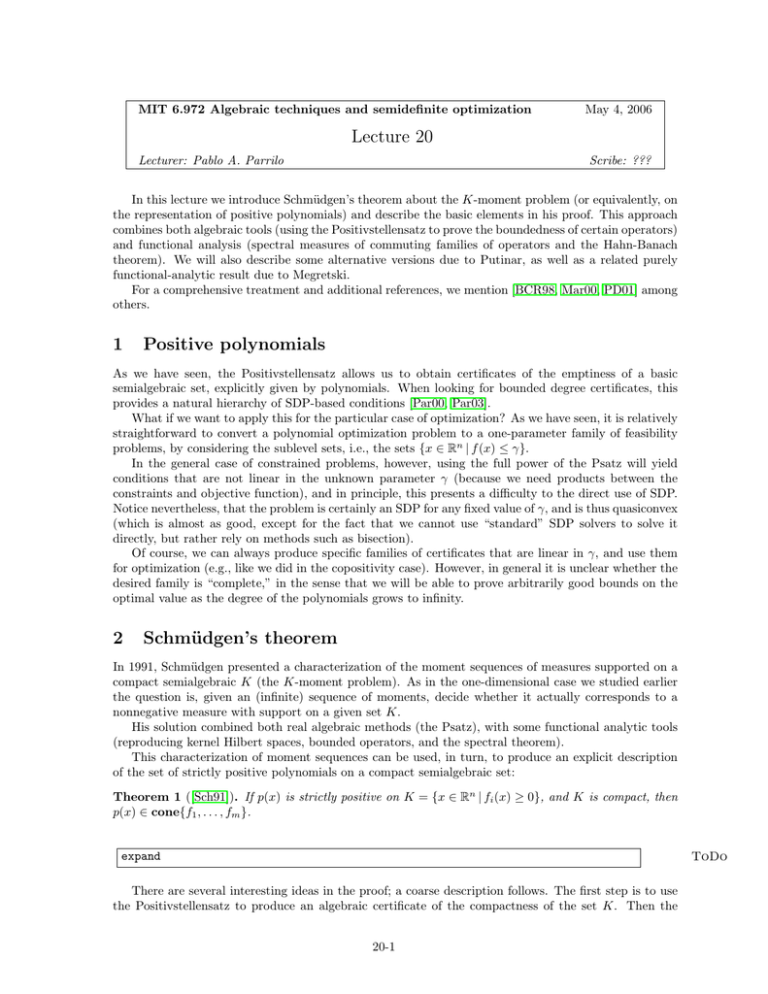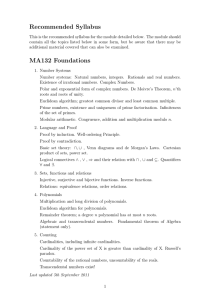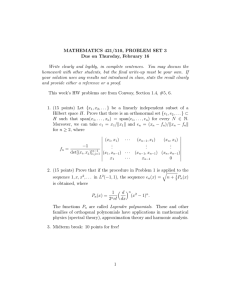Lecture 20
advertisement

MIT 6.972 Algebraic techniques and semidefinite optimization
May 4, 2006
Lecture 20
Lecturer: Pablo A. Parrilo
Scribe: ???
In this lecture we introduce Schmüdgen’s theorem about the K­moment problem (or equivalently, on
the representation of positive polynomials) and describe the basic elements in his proof. This approach
combines both algebraic tools (using the Positivstellensatz to prove the boundedness of certain operators)
and functional analysis (spectral measures of commuting families of operators and the Hahn­Banach
theorem). We will also describe some alternative versions due to Putinar, as well as a related purely
functional­analytic result due to Megretski.
For a comprehensive treatment and additional references, we mention [BCR98, Mar00, PD01] among
others.
1
Positive polynomials
As we have seen, the Positivstellensatz allows us to obtain certificates of the emptiness of a basic
semialgebraic set, explicitly given by polynomials. When looking for bounded degree certificates, this
provides a natural hierarchy of SDP­based conditions [Par00, Par03].
What if we want to apply this for the particular case of optimization? As we have seen, it is relatively
straightforward to convert a polynomial optimization problem to a one­parameter family of feasibility
problems, by considering the sublevel sets, i.e., the sets {x ∈ Rn | f (x) ≤ γ}.
In the general case of constrained problems, however, using the full power of the Psatz will yield
conditions that are not linear in the unknown parameter γ (because we need products between the
constraints and objective function), and in principle, this presents a difficulty to the direct use of SDP.
Notice nevertheless, that the problem is certainly an SDP for any fixed value of γ, and is thus quasiconvex
(which is almost as good, except for the fact that we cannot use “standard” SDP solvers to solve it
directly, but rather rely on methods such as bisection).
Of course, we can always produce specific families of certificates that are linear in γ, and use them
for optimization (e.g., like we did in the copositivity case). However, in general it is unclear whether the
desired family is “complete,” in the sense that we will be able to prove arbitrarily good bounds on the
optimal value as the degree of the polynomials grows to infinity.
2
Schmüdgen’s theorem
In 1991, Schmüdgen presented a characterization of the moment sequences of measures supported on a
compact semialgebraic K (the K­moment problem). As in the one­dimensional case we studied earlier
the question is, given an (infinite) sequence of moments, decide whether it actually corresponds to a
nonnegative measure with support on a given set K.
His solution combined both real algebraic methods (the Psatz), with some functional analytic tools
(reproducing kernel Hilbert spaces, bounded operators, and the spectral theorem).
This characterization of moment sequences can be used, in turn, to produce an explicit description
of the set of strictly positive polynomials on a compact semialgebraic set:
Theorem 1 ([Sch91]). If p(x) is strictly positive on K = {x ∈ Rn | fi (x) ≥ 0}, and K is compact, then
p(x) ∈ cone{f1 , . . . , fm }.
expand
ToDo
There are several interesting ideas in the proof; a coarse description follows. The first step is to use
the Positivstellensatz to produce an algebraic certificate of the compactness of the set K. Then the
20­1
given moment sequence (which is a positive definite function on the semigroup of monomials) is used to
construct a particular pre­Hilbert space and its completion (namely, the associated reproducing kernel
Hilbert space). In this Hilbert space, we consider linear operators Txi given by multiplication by the
coordinate variables, and use the algebraic certificate of compactness to prove that these are bounded.
Now, the Txi are a finite collection of pairwise commuting, bounded, self­adjoint operators, and thus
there exists a spectral measure for the family, from which a measure, only supported in K, can be
extracted. Finally, a Hahn­Banach (separating hyperplane) argument is used to prove the final result.
2.1
Putinar’s approach
The theorem in the previous section requires (in principle) all 2m − 1 squarefree products of constraints1 .
Putinar [Put93] presented a modified formulation (under stronger assumptions) for which the represen­
tation is linear in the constraints. We introduce the following concept:
Definition 2. Let {f1 , . . . , fm } ⊂ R[x]. The preprime generated by the fi , and denoted by preprime{f1 , . . . , fm }
is the set of all polynomials of the form s0 + s1 f1 + · · · + sm fm , where all the si are sums of squares.
Notice that preprime{fi } ⊂ cone{fi }, and that every element in the preprime takes only nonneg­
ative values on {x ∈ Rn , fi (x) ≥ 0}.
Theorem 3 ([Put93]). Consider a set K = {x ∈ Rn | fi (x) ≥ 0}, such that there exists a q ∈
preprime{f1 , . . . , fm } and {x ∈ Rn , q(x) ≥ 0} is compact (this implies that K is compact). Then,
p(x) > 0 on K if and only if p(x) ∈ preprime{f1 , . . . , fm }.
Notice that here, the polynomial q serves as an algebraic certificate of the compactness of K, so in
this case the Psatz is not needed.
Putinar’s theorem was used by Lasserre to present a hierarchy of semidefinite relaxations for poly­
nomial optimization, based on the dual moment interpretation [Las01].
2.2
Tradeoffs
In principle (and often, in practice) there is a tradeoff between how “expressive” our family of certificates
is, the quality of the resulting bounds, and the complexity of finding proofs.
On one extreme, the most general method is the Psatz, as it encapsulates pretty much every possi­
ble “algebraic deduction,” and will certainly provide the strongest bounds, since it includes the other
techniques as special cases. For optimization, Schmüdgen’s theorem provides the advantages of a linear
representation, although (possibly) at the cost of having a large number of products between the con­
straints. Finally, the Putinar approach has a reduced number of constraints (and thus, SOS multipliers),
although the obtained bounds can potentially be much weaker than the previous ones.
In the end, the decision concerning what approach to use should be dictated by the available com­
putational resources, i.e., the size of the SDPs that we can solve in a reasonable time. It is not difficult
to produce examples with significant gaps between the corresponding bounds; see for instance [Ste96]
for a particularly simple example, that is trivial for the Psatz, but for which either the Schmüdgen or
Putinar representations need large degree refutations.
Add examples
ToDo
1 Recall that in practice, this may not be a issue at all, since the restriction on the degree of the certificates imposes a
strict limit on how many products can be included.
20­2
2.3
Trigonometric case
Recently, Megretski [Meg03] analyzed the trigonometric case. We introduce the following notation: let
Tn = {z ∈ Cn , |zi | = 1} be the n­dimensional torus, Pn is the set of multivariate Laurent polynomials,
and RPn ⊂ Pn are the Laurent polynomials that are real­valued on Tn .
Theorem 4 ([Meg03]). Let {F, Q1 , . . . , Qm } ⊂ RPn , such that F (z) > 0 for all z ∈ Tn satisfying
Q1 (z) = . . . = Qm (z) = 0. Then there exist V1 , . . . , Vr ∈ Pn , H1 , . . . , Hm ∈ RPn , such that
F (z) =
r
�
|Vi (z)|2 +
i=1
m
�
Hj (z)Qi (z).
j=1
Notice that, by splitting into real and imaginary part, this corresponds to a special kind of (standard)
polynomials, and a compact semialgebraic set (so in principle, any of the previous theorems would apply).
Of course, the result exploits the complex structure for a more concise representation.
In particular, Megretski’s proof is purely functional­analytic, the main tools being Bochner’s theorem
and Hahn­Banach. Bochner’s theorem is an important result in harmonic analysis, that characterizes a
positive definite function on an Abelian group in terms of the nonnegativity of its Fourier transform.
Notice that the theorem above deals only with the equality case (no inequalities), and the feasible set
is compact (since so it Tn ). It essentially states that a positive polynomial is a sum of squares modulo
the ideal generated by the Qi . Recall we have proved similar results in the zero­dimensional case, and
this theorem naturally generalizes these.
In simplified terms, one reason why trigonometric (or Laurent) polynomials are somewhat “easier”
than the general case is because in this case there is a group structure, as opposed to the semigroup
structure of regular monomials. For the group case, the corresponding theory is the classical harmonic
analysis on abelian groups (e.g., [Rud90]); while for semigroups there is the newer, but well­developed
characterizations of positive functions on (Abelian) semigroups; see for instance [BCR84].
We also mention that there are “purely algebraic” versions of these theorems, that do not use func­
tional analytic ideas (e.g., [Mar00]). Roughly, the role played by the compactness of K in proving the
boundedness of the operators Txi is replaced with a property called Archimedeanity of the corresponding
preorder.
References
[BCR84] C. Berg, J. P. R. Christensen, and P. Ressel. Harmonic analysis on semigroups, volume 100 of
Graduate Texts in Mathematics. Springer­Verlag, New York, 1984.
[BCR98] J. Bochnak, M. Coste, and M­F. Roy. Real Algebraic Geometry. Springer, 1998.
[Las01]
J. B. Lasserre. Global optimization with polynomials and the problem of moments. SIAM J.
Optim., 11(3):796–817, 2001.
[Mar00] M. Marshall. Positive polynomials and sums of squares. Dottorato de Ricerca in Matematica.
Dept. di Mat., Univ. Pisa, 2000.
[Meg03] A. Megretski. Positivity of trigonometric polynomials. In Proceedings of the 42th IEEE Con­
ference on Decision and Control, pages 3814–3817, 2003.
[Par00]
P. A. Parrilo. Structured semidefinite programs and semialgebraic geometry methods in robust­
ness and optimization. PhD thesis, California Institute of Technology, May 2000. Available at
http://resolver.caltech.edu/CaltechETD:etd­05062004­055516.
[Par03]
P. A. Parrilo. Semidefinite programming relaxations for semialgebraic problems. Math. Prog.,
96(2, Ser. B):293–320, 2003.
20­3
[PD01]
A. Prestel and C. N. Delzell. Positive polynomials: from Hilbert’s 17th problem to real algebra.
Springer Monographs in Mathematics. Springer, 2001.
[Put93]
M. Putinar. Positive polynomials on compact semi­algebraic sets. Indiana Univ. Math. J.,
42(3):969–984, 1993.
[Rud90] W. Rudin. Fourier analysis on groups. Wiley Classics Library. John Wiley & Sons Inc., New
York, 1990.
[Sch91]
K. Schmüdgen. The K­moment problem for compact semialgebraic sets. Math. Ann., 289:203–
206, 1991.
[Ste96]
G. Stengle. Complexity estimates for the Schmüdgen Positivstellensatz.
12(2):167–174, 1996.
20­4
J. Complexity,





